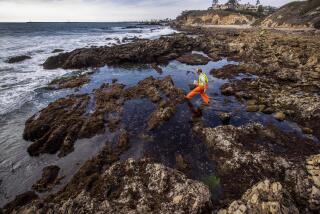Plan Outlines Studies to Assess Alaskan Spill Damage, Exxon’s Restoration Costs
- Share via
WASHINGTON — In an effort to develop a long-term strategy to restore the oil-fouled Alaskan environment, an inter-agency council released a comprehensive plan Tuesday for studying almost every type of wildlife and natural resource harmed by the Exxon Valdez tanker spill.
The 250-page plan, which outlines environmental studies to be completed by the end of February, 1990, will be used to identify the extent of the damage and to assess funds from Exxon to pay for restoration projects.
The council did not attempt to estimate the dollar cost of the anticipated restoration projects, which would extend beyond current cleanup efforts to encompass such things as replenishment of wildlife populations.
Cost Put at $35 Million
The cost of conducting the studies is estimated at $35 million, of which Exxon has already paid $15 million. The giant oil company, which has paid $1.2 billion in cleanup expenses so far, will be charged for the balance of the study as well as the additional restoration costs.
Representatives of the state of Alaska and the Agriculture, Commerce and Interior departments will put the plan into effect in October, after the public has had a chance to comment on it. The council will be assisted by the Environmental Protection Agency.
“Recognizing the need to act quickly in the wake of the accident, the trustee agencies have begun virtually all of the studies outlined,” the Interior Department said in a statement.
Under terms of the plan, no additional studies will be conducted after Feb. 28, 1990, “except those approved . . . as being necessary to promote restoration and to support assessment of legally recoverable natural resource damages.”
Groups Assail Plan
Environmental groups immediately attacked the plan for limiting the length of the studies to one year, arguing that the short timetable could cause the spill damages to be significantly underestimated.
“The first year’s damages tell only part of the story. Oil will not disappear in a year,” said Sarah Chasis, a senior attorney with the Natural Resources Defense Council, a private environmental research organization based in Washington.
Young salmon and bald eagles born this year will not return to Prince William Sound for two to four years, Chasis said, noting that a more accurate estimate of damages should span several years.
“This one-year plan could lead to a serious underestimation of harm to the environment and a limited recovery of damages from Exxon,” Chasis said.
Exxon officials could not be reached for comment. The company has pledged to pay for cleanup costs incurred through Sept. 15, but it has made no firm commitment to cover additional expenses.
Focus on Wildlife Injuries
As well as studying air and water pollution in Prince William Sound, the council will examine injuries caused to most types of wildlife affected by the oil spill.
Included among 13 species of fish to be studied are salmon, herring, clams, crab and rockfish. Among 10 types of mammals to be studied are sea lions, sea otters, humpback whales, Sitka black-tail deer and brown bears. Bald eagles and peregrine falcons are included among 10 species of birds to be examined.
The report also will study the economic impact of the oil spill on commercial fisheries, public land, recreational use of Prince William Sound and archeological sites.
Each study will include three steps: documenting exposure of each resource to oil, measuring the adverse effects on the resource and estimating the economic cost of the injury. “The economic value of the lost or injured natural resources is based on the goods and services they provide humans,” the plan said.
The funds that the council plans to assess from Exxon will be used to “restore, replace or acquire the equivalent of the injured natural resource.”
Environmentalists also assailed the plan for its ambiguity about Exxon’s role. The plan states that the agencies have not decided “whether, or to what extent, potentially responsible parties should participate in the damage assessment.”
Allowing Exxon to participate “would be like asking the fox to evaluate how many chickens he ate,” said Bob Adler of the Natural Resources Defense Council.
“The assessment ought to be made by independent scientists . . . and not by people who caused the damage and are going to pay the bill,” said Eric Jorgensen, a staff attorney with the Sierra Club Legal Defense Fund in Juneau, Alaska.
Prince William Sound was coated with about 11 million gallons of crude oil when the tanker Exxon Valdez ran aground on March 24. The resulting oil slick has killed an estimated 30,000 sea birds, 127 bald eagles and at least 1,000 sea otters.
More to Read
Sign up for Essential California
The most important California stories and recommendations in your inbox every morning.
You may occasionally receive promotional content from the Los Angeles Times.













